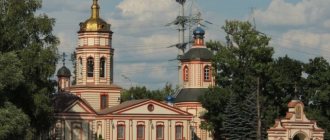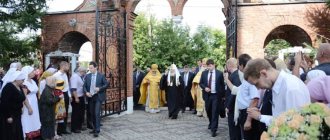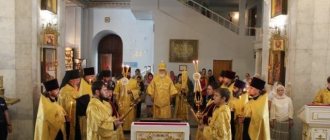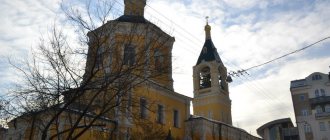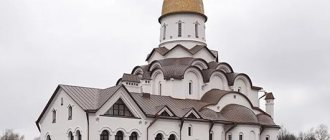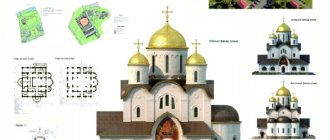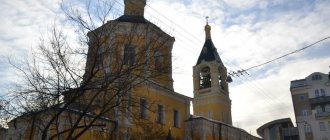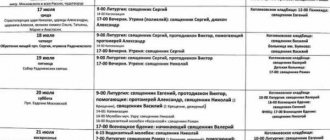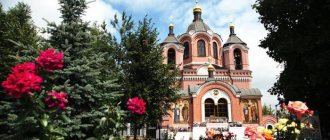Mir
Russia Moscow Temple of Elijah the Prophet in Cherkizovo (Moscow) Map is loading...
{"format":"leaflet","minzoom":false,"maxzoom":false,"limit":50,"offset":0,"link":"all","sort":[""], "order":[],"headers":"show","mainlabel":"","intro":"","outro":"","searchlabel":"\u2026 \u0441\u043b\u0435\ u0434\u0443\u044e\u0449\u0438\u0435 \u0440\u0435\u0437\u0443\u043b\u044c\u0442\u0430\u0442\u044b","default":"","import-annotation":false,"width ":"auto","height":"350px","centre":{"text":"","title":"""link":"""lat":55.8002800000000007685230229981243610382080078125,"lon": 37.73416999999999887904778006486594676971435546875,"icon":""},"title":"","label":"","icon":"","lines":[],"polygons":[],"circles":[ ],"rectangles":[],"copycoords":false,"static":false,"zoom":8,"defzoom":14,"layers":["OpenStreetMap"],"image layers":[] ,"overlays":[],"resizable":false,"fullscreen":true,"scrollwheelzoom":true,"cluster":false,"clustermaxzoom":9,"clusterzoomonclick":true,"clustermaxradius":80, "clusterspiderfy":true,"geojson":"","clicktarget":"","showtitle":true,"hidenamespace":false,"template":"","userparam":"","activeicon": "","pagelabel":false,"ajaxcoordproperty":"","ajaxquery":"","locations":[{"text":"\u003Cb\u003E\u003Ca href=\"/palomnik/%D0% A5%D1%80%D0%B0%D0%BC_%D0%98%D0%BB%D0%B8%D0%B8_%D0%BF%D1%80%D0%BE%D1%80%D0%BE% D0%BA%D0%B0_%D0%B2_%D0%A7%D0%B5%D1%80%D0%BA%D0%B8%D0%B7%D0%BE%D0%B2%D0%B5_(%D0 %9C%D0%BE%D1%81%D0%BA%D0%B2%D0%B0)\» title=\»\u0425\u0440\u0430\u043c \u0418\u043b\u0438\u0438 \u043f\u0440\ u043e\u0440\u043e\u043a\u0430 \u0432 \u0427\u0435\u0440\u043a\u0438\u0437\u043e\u0432\u0435 (\u041c\u043e\u0441\u043a\u0432\u 0430)\»\u003E\u0425\ u0440\u0430\u043c \u0418\u043b\u0438\u0438 \u043f\u0440\u043e\u0440\u043e\u043a\u0430 \u0432 \u0427\u0435\u0440\u043a\u0438\ u0437\u043e\u0432\u0435 (\u041c \u043e\u0441\u043a\u0432\u0430)\u003C/a\u003E\u003C/b\u003E\u003Chr /\u003E\u003Ca href=\"/palomnik/%D0%A1%D0%B2%D0%BE% D0%B9%D1%81%D1%82%D0%B2%D0%BE:%D0%90%D0%BD%D0%BD%D0%BE%D1%82%D0%B0%D1%86%D0 %B8%D1%8F\" title=\"\u0421\u0432\u043e\u0439\u0441\u0442\u0432\u043e:\u0410\u043d\u043d\u043e\u0442\u0430\u0446\u0438\u044f\"\ u003E\u0410\u043d\u043d\u043e\u0442\u0430\u0446\u0438\u044f\u003C/a\u003E: "'\u0425\u0440\u0430\u043c \u0418\u043b\u0438\u04 38\u041f\u0440\u043e \u0440\u043e\u043a\u0430"' (\u0412\u043e\u0437\u0434\u0432\u0438\u0436\u0435\u043d\u0438\u044f \u041a\u0440\u0435\u0441\u044 2\u0430\u0413\u043e\ u0441\u043f\u043e\u0434\u043d\u044f)\u0432 \u0427\u0435\u0440\u043a\u0438\u0437\u043e\u0432\u0435 \u2014 \u043f\u0440\u0430 \u0432\u043e\u0441\u043b\u0430 \u0432\u043d\u044b\u0439 \u0445\u0440\u0430\u043c \u0412\u043e\u0441\u043a\u0440\u0435\u0441\u0435\u043d\u0441\u043a\u043e\ u0433\u043e\u0431\u043b\u0430 \u0433\u043e\u0447\u0438\u043d\u0438\u044f \u041c\u043e\u0441\u043a\u043e\u0432\u0441\u043a\u043e\u0439 \u0433\u043e\u0440\ u043e\u0434\u0441\u043a\u043e \u0439 \u0435\u043f\u0430\u0440\u0445\u0438\u0438. \u0425\u0440\u0430\u043c \u0440\u0430\u0441\u043f\u043e\u043b\u043e\u0436\u0435\u043d \u0432 \u0440\u0430\u0439\u043e\u043d \u0435\u041f\u0440\u0435\u043e \u0431\u0440\u0430\u0436\u0435\u043d\u0441\u043a\u043e\u0435, \u0412\u043e\u0441\u0442\u043e\u0447\u043d\u043e\u0433\u043e \u0430\u0434\u043c\u0438\ u043d\u0438\u0441\u0442\u0440\u0430\u0442\u0438\u0432\u043d\u043e\u0433\u043e\u043e\u043a\u0440\u0443\u0433\u0430\u0433\u0 43e\u0440\u043e\u0434\u0430\ u041c\u043e\u0441\u043a\u0432\u044b.","title":"\u0425\u0440\u0430\u043c \u0418\u043b\u0438\u0438 \u043f\u0440\u043e\u0440\u043e\u 043a\u0430\ u0432 \u0427\u0435\u0440\u043a\u0438\u0437\u043e\u0432\u0435 (\u041c\u043e\u0441\u043a\u0432\u0430)","link":"","lat":55.800280000000 0007685230229981243610382080078125,”lon ":37.73416999999999887904778006486594676971435546875,"icon":""}],"imageLayers":[]}
55.800246; 37.734353
Russia, Moscow, Bolshaya Cherkizovskaya street, 17
Moscow
Russia
Telephone:
(499) 161-81-82 (temple), (499) 161-20-25 (treasurer).
Phone number of the priest on duty
: +7 926 4120340.
Temple of Elijah the Prophet
(Exaltation of the Holy Cross) in Cherkizovo is an Orthodox church of the Resurrection Deanery of the Moscow City Diocese. The temple is located in the Preobrazhenskoye district, Eastern administrative district of Moscow.
History[edit]
The history of the Elias Church is inextricably linked with the history of the village of Cherkizovo, where it was built in the 14th century. The village got its name from its owner, Tsarevich Serkizi, who after baptism became Ivan Serkizov. Ivan Serkizov owned the village for a short time and then sold it to another native of the Golden Horde, Ilya Ozakov. Ilya Ozakov was a baptized Tatar and a very devout person. It was he who built a church in Cherkizovo in honor of his heavenly patron, Elijah the Prophet.
Elias Church was located in a picturesque place, on the banks of the Sosenka River. Sosenka is the right tributary of Khapilovka, its source is located in the Golyanov region, and the length of the entire river is almost nine kilometers. Currently, the main part of the Sosenka channel is enclosed in a pipe. Cherkizovsky Pond, on the banks of which the Ilyinskaya Church still stands, is one of the few places reminiscent of where the river previously flowed on the surface. The river itself flows in a collector along the eastern shore of the pond.
Together with his brother Sergei, Ilya was one of the close servants of Metropolitan Alexy. It was to the metropolitan that Cherkizovo passed from Ilya Ozakov. Metropolitan Alexy liked the picturesque location of the village, and he made the temple the summer residence of the Moscow patriarchs. Over time, especially under Saint Innocent (Veniaminov), the residence grew and was rebuilt.
In 1689-1690, a stone church was built on the site of a burnt wooden church. The temple was consecrated on June 18, 1690, it already had a chapel of St. Alexis, a refectory and a belfry. In the 19th century, the Elias Church was rebuilt twice. After the first reconstruction in 1821-1825, the temple for some time became five-domed. A more serious reconstruction was carried out at the end of the 19th century on the initiative of the rector of the church, Father Paul, and the church warden, merchant Alexander Zelenyaev, who wrote in an appeal to the diocesan authorities: “The Church of the Holy Prophet Elijah in the village of Cherkizovo does not correspond to a fairly significant number of parishioners...”. The plan for the reconstruction of the church and the construction of a new bell tower according to the design of the architect Egorov was approved in 1888. After the completion of work in the late 1890s, the temple was re-consecrated.
Elias Church is surrounded by a cemetery, which is the oldest cemetery in Moscow. This is one of the rare domestic historical necropolises that was not destroyed during the Soviet era. In 1861, the famous Moscow holy fool Ivan Yakovlevich Koreysha, who was revered as a saint for a long time, was buried here. His popularity is evidenced by the fact that the image of Koreyshi is captured in the works of N. S. Leskov (“Little Mistake”) and F. M. Dostoevsky (“Demons”). Ivan Yakovlevich is mentioned by A. N. Ostrovsky (“The Marriage of Balzaminov”).
During the Great Patriotic War, the believers and clergy of the temple collected 1 million rubles for the construction of aircraft and sent them to I.V. Stalin. Stalin sent a telegram of gratitude in response. And the temple survived all the difficult years of Soviet rule. In the middle of the 20th century, icons from neighboring churches that were to be destroyed were brought to the temple. The rector of the temple at that time was Pavel Ivanovich Tsvetkov.
On December 30, 2011, Archimandrite Savva (in the world Sergei Andreevich Tutunov; February 19, 1978, Villecrins, France) was appointed rector of the church - archimandrite of the Russian Orthodox Church, deputy administrator of the Moscow Patriarchate and head of the control and analytical service of the Moscow Patriarchate Administration, member of the Inter-Council Presence of the Russian Orthodox Church.
Schedule of services
The schedule of services in the Church of Elijah the Prophet Cherkizov is the same as in other monasteries. The only difference is that they have their own holidays, during which other prayer services may be held.
The best article for you, go to: Church of the Transfiguration of the Lord on Preobrazhenskaya Square
Liturgy takes place daily at 8 a.m., Vespers and Matins (except Mondays and Tuesdays) at 5 p.m. On Sundays and holidays, all Liturgies are held at 7.00 and 10.00. The day before, an all-night vigil is held at 18.00, and in winter at 17.00.
In order to know exactly the schedule at the church in Cherkizovo, you can call the church and clarify this information or go to the official website and see the list for the current month.
Patronal holidays[edit]
Exaltation of the Life-Giving Cross of the Lord
- September 27
Elijah the Tishbite, prophet
- August 2
Alexy of Moscow, saint, wonderworker
- 25 February
Icon of the Most Holy Theotokos “Iverskaya”
— October 26, February 25, May 6
Current state
The beginning of the new millennium was marked by the appearance of a forged fence around the temple complex. In 2006, the bells began to sing again, re-cast and donated to the ancient shrine.
Archimandrite Savva became the rector of the Church of the Holy Prophet Elijah in Cherkizovo in 2011, under his leadership Archpriest Chvilev, five priests, a protodeacon and a deacon.
The temple complex includes thrones:
- Exaltation of the Cross of the Lord;
- Saint Alexy, Metropolitan:
- Prophet Saint Elijah.
On August 2, the temple courtyard was completely filled with parishioners who came to the service on the occasion of the patronal feast day in honor of Elijah the prophet of God.
The village was given according to a spiritual will
Somewhere in the 60s of the 14th century, Ilya Ozakov sold his villages near Moscow to St. Alexy, Metropolitan of Moscow. Among them, Cherkizovskoye is mentioned, given, in turn, according to the spiritual will of the metropolitan “to the monastery of the Holy Archangel Chuda” in 1378. Thus, the village becomes one of the main estates of the Moscow Cathedral Chudov Monastery with an extensive monastic (lord's) courtyard and a developed monastic economy.
Cherkizovo was a very distant outskirts from the noisy Moscow. Here everything was conducive to solitude and relaxation in nature, surrounded by oak forests located along the picturesque Sosenka River, a tributary of the Yauza. A bishop's dacha was built for Metropolitan Alexy, where he usually came in the warm season. This place served as a summer residence both for himself and subsequently for his successors. “Tsar John Vasilyevich and his princes went hunting to Cherkizovo in 1564,” Pyotr Sinitsyn mentions in his book.
Cherkizovskoe cemetery
Cherkizovskoye Cemetery is the smallest Moscow cemetery and one of the oldest cemeteries in Moscow. The Cherkizovskoe cemetery received its name from the village of Cherkizovo, near which the cemetery was founded in 1380. In 1960, the Cherkizovskoye cemetery became part of the Moscow cemeteries under the jurisdiction of the State Unitary Enterprise "Ritual". Since 1998, an archive has been maintained at the Cherkizovsky cemetery in which all burials are registered. At the cemetery there is a rental point for equipment for caring for graves. Currently, related burials are being carried out at the Cherkizovsky cemetery. Cherkizovskoye Cemetery is open to the public daily from May to September from 9 a.m. to 7 p.m. and from October to April from 9 a.m. to 5 p.m. Burials at the Cherkizovsky cemetery take place daily from 9 a.m. to 5 p.m.
Buried in the cemetery:
- Ivan Yakovlevich Koreysha (-) - famous Moscow holy fool
- Bragin Sergey Mikhailovich (-) - professor
- Zamyatin Nikolai Mikhailovich (-) - Major General
- Smirnov Pavel Dmitrievich (-) - priest
- Sokolov Alexey Pavlovich (-) - archpriest
- Ilyin Nikolai Ilyich (-) - rector of the temple
- Glushakov Alexey Vasilievich (-) - rector of the temple
- Koroleva Nadezhda Aleksandrovna (-) – labor veteran
- Elkin Ivan Vladimirovich (-) - military pilot
Excerpt characterizing the Temple of Elijah the Prophet in Cherkizovo
- We'll clean it up for you now.
- And Timokhin, not yet dressed, ran to clean it. - The prince wants it. - Which? Our prince? - voices spoke, and everyone hurried so much that Prince Andrey managed to calm them down. He came up with a better idea to take a shower in the barn. “Meat, body, chair a canon [cannon fodder]! - he thought, looking at his naked body, and shuddering not so much from the cold as from an incomprehensible disgust and horror at the sight of this huge number of bodies rinsing in the dirty pond. On August 7, Prince Bagration, in his Mikhailovka camp on the Smolensk road, wrote the following: “Dear Sir, Count Alexey Andreevich. (He wrote to Arakcheev, but knew that his letter would be read by the sovereign, and therefore, as far as he was capable of it, he thought about his every word.) I think that the minister had already reported on the abandonment of Smolensk to the enemy. It’s painful, sad, and the whole army is in despair that the most important place was abandoned in vain. I, for my part, asked him personally in the most convincing way, and finally wrote; but nothing agreed with him. I swear to you on my honor that Napoleon was in such a bag as never before, and he could have lost half the army, but not taken Smolensk. Our troops fought and are fighting like never before. I held 15 thousand for more than 35 hours and beat them; but he didn’t want to stay even 14 hours. This is shameful and a stain on our army; and it seems to me that he himself should not even live in the world. If he reports that the loss is great, it is not true; maybe about 4 thousand, no more, but not even that. Even if it’s ten, there’s war! But the enemy lost the abyss... Why was it worth staying two more days? At least they would have left on their own; for they had no water to drink for the people and horses. He gave me his word that he would not back down, but suddenly he sent a disposition that he was leaving that night. It’s impossible to fight this way, and we can soon bring the enemy to Moscow... There are rumors that you are thinking about peace. To make peace, God forbid! After all the donations and after such extravagant retreats - put up with it: you will put all of Russia against you, and each of us will be forced to wear a uniform for shame. If this has already happened, we must fight while Russia can and while people are on their feet... We must command one, not two. Your minister may be a good one in his ministry; but the general is not only bad, but trashy, and the fate of our entire Fatherland was given to him... I’m really going crazy with frustration; forgive me for writing impudently. Apparently, he does not like the sovereign and wishes death for all of us, who advises us to make peace and command the army to the minister. So, I write to you the truth: prepare your militia. For the minister most masterfully leads the guest to the capital with him. Mr. Adjutant Wolzogen casts great suspicion on the entire army. He, they say, is more Napoleon than ours, and he advises everything to the minister. I am not only polite against him, but I obey like a corporal, although older than him. It hurts; but, loving my benefactor and sovereign, I obey. It’s just a pity for the sovereign that he entrusts such a glorious army to such people. Imagine that during our retreat we lost more than 15 thousand people from fatigue and in hospitals; but if they had attacked, this would not have happened. Tell me for God's sake that our Russia - our mother - will say that we are so afraid and why we are giving such a good and diligent Fatherland to the bastards and instilling hatred and shame in every subject. Why be afraid and who to be afraid of? It is not my fault that the minister is indecisive, cowardly, stupid, slow and has all bad qualities. The whole army is completely crying and cursing him to death...” Among the countless divisions that can be made in the phenomena of life, one can subdivide them all into those in which the content predominates, others in which the form predominates. Among these, in contrast to village, zemstvo, provincial, and even Moscow life, one can include St. Petersburg life, especially salon life. This life is unchanged. Since 1805, we have made peace and quarreled with Bonaparte, we have made constitutions and divided them, and Anna Pavlovna’s salon and Helen’s salon were exactly the same as they were, one seven years, the other five years ago. In the same way, Anna Pavlovna spoke with bewilderment about Bonaparte’s successes and saw, both in his successes and in the indulgence of European sovereigns, a malicious conspiracy, with the sole purpose of causing trouble and anxiety to the court circle of which Anna Pavlovna was a representative. In the same way, with Helen, whom Rumyantsev himself honored with his visit and considered a remarkably intelligent woman, in the same way, both in 1808 and in 1812, they spoke with delight about a great nation and a great man and looked with regret at the break with France, which, according to the people who gathered in Helen's salon, it should have ended peacefully. Recently, after the arrival of the sovereign from the army, there was some unrest in these opposing circles in the salons and some demonstrations were made against each other, but the direction of the circles remained the same. Only inveterate legitimists were accepted into Anna Pavlovna’s circle from the French, and here the patriotic idea was expressed that there was no need to go to the French theater and that maintaining a troupe costs the same as maintaining an entire corps. Military events were followed greedily, and the most beneficial rumors for our army were spread. In Helen's circle, Rumyantsev's, French, rumors about the cruelty of the enemy and the war were refuted and all Napoleon's attempts at reconciliation were discussed. In this circle, they reproached those who advised too hasty orders to prepare for departure to Kazan to court and women's educational institutions under the patronage of the Empress Mother. In general, the whole matter of war was presented in Helen’s salon as empty demonstrations that would very soon end in peace, and the opinion of Bilibin, who was now in St. Petersburg and at Helen’s house (every intelligent person should have been with her), reigned that it was not gunpowder, but those who invented, they will solve the matter. In this circle, ironically and very cleverly, although very carefully, they ridiculed the Moscow delight, the news of which arrived with the sovereign in St. Petersburg. In Anna Pavlovna's circle, on the contrary, they admired these delights and talked about them, as Plutarch says about the ancients. Prince Vasily, who occupied all the same important positions, formed the link between the two circles. He went to see ma bonne amie [his worthy friend] Anna Pavlovna and went dans le salon diplomatique de ma fille [to his daughter’s diplomatic salon] and often, during his constant transfers from one camp to another, he got confused and told Anna Pavlovna what it was necessary to talk to Helen, and vice versa. Soon after the arrival of the sovereign, Prince Vasily talked with Anna Pavlovna about the affairs of the war, cruelly condemning Barclay de Tolly and being indecisive about who to appoint as commander-in-chief. One of the guests, known as un homme de beaucoup de merite [a man of great merit], having said that he had now seen Kutuzov, who had now been elected head of the St. Petersburg militia, sitting in the state chamber to receive warriors, allowed himself to cautiously express the assumption that that Kutuzov would be the person who would satisfy all the requirements. Anna Pavlovna smiled sadly and noticed that Kutuzov, apart from troubles, gave nothing to the sovereign. “I spoke and spoke in the Assembly of Nobles,” interrupted Prince Vasily, “but they did not listen to me.” I said that the sovereign would not like his election as commander of the militia. They didn't listen to me.
What is what in the church
A baptized Tatar, Ilya Ozakov was close to Metropolitan Alexy, so he bequeathed Cherkizovo to the Chudov Monastery. The metropolitan liked the picturesque location of the village, and he made the temple the summer residence of the Moscow patriarchs.
The stone church was built in 1689-1690 and rebuilt twice: in 1821-1825 the temple became five-domed, and in the late 1890s it was rebuilt according to Egorov’s design and supplemented with a bell tower.
Elias Church is surrounded by the oldest cemetery in Moscow. This necropolis survived even during Soviet times.
In 1861, the famous Moscow holy fool Ivan Koreysha was buried here. He was revered as a saint and was even depicted on the pages of the books “A Little Mistake” by N.S. Leskova and “Demons” by F.M. Dostoevsky.
During the Great Patriotic War, believers and clergy of the Church of Elijah the Prophet in Cherkizovo collected 1 million rubles for the construction of aircraft and sent them to Stalin. He responded with a telegram of gratitude. Perhaps that is why the temple was not closed, although they planned to run a metro line under it. Metro construction workers admitted that the tunnel had already been built, but an order came “from above”, and the line had to be turned to the side. Therefore, metro trains slow down sharply in the middle of the journey from the Preobrazhenskaya Ploshchad to Cherkizovskaya station.
And in the middle of the 20th century, icons from dismantled churches were brought to the Church of Elijah the Prophet in Cherkizovo.
The massive construction of Orthodox churches always suggests that religion is truly a necessary spiritual “medicine” for the people. This statement cannot be refuted, because in fact it is so. In religion one can find a certain peace and tranquility, and a person can also receive explanations for what was not available in other areas.
Construction of a stone church
During the Time of Troubles of the Polish-Lithuanian attack on Rus', the Elijah Church was burned by the enemy, but was soon restored. The construction of the stone Cherkizovsky church dates back to the reign of the ever-memorable Patriarch Adrian, the last patriarch of the pre-Petrine era.
Under his wise leadership, all the monastery buildings were rebuilt and several churches were erected. Since Cherkizovo in those years was considered the patrimony of this Moscow monastery, it must be assumed that appropriate attention was paid to it. In all likelihood, the construction of the Eliinsky Temple took place in 1689–1690. Thus, according to the testimony of the famous Russian writer of the 17th–18th centuries Karion Istomin, on June 18, 1690, the newly built Church of the Holy Prophet Elijah in Cherkizovo was consecrated by the abbot of the Chudov monastery, Archimandrite Joasaph, and cellarer German Lutokhin, and “decorated with all kinds of ornaments.” Chronicles of this period also report a parish cemetery where a wooden chapel stood.
It must be said that from the end of the 17th – beginning of the 18th centuries, there has been an increase in the population of Cherkizovo, due to which the number of parishioners increases, and the temple itself becomes more magnificent. According to the inventory of 1701: “... stone in the name of the Prophet Elijah, and in the chapel of Metropolitan Alexei with a refectory... in the altar there are two windows, and in the church there is one glass window... and in the refectory there are three glass windows in the windows, a mural stove, and on the refectory wall there is a bell tower stone, and there are five bells on it.”
By decree of Empress Elizabeth Petrovna and by decision of the Holy Governing Synod, the Monastery of the Miracle of St. Archangel Michael in Kolosy from a stauropegial metropolitan monastery with the establishment of the Moscow Metropolitan Department in it is transformed into the Moscow Cathedral Miracle Monastery with the residence of the Metropolitan of Moscow. In this regard, the importance of the village of Cherkizova is increasing.
Since 1764, the church in the name of the Holy Prophet of God Elijah leaves the compound and becomes a parish church.
New time
In the first decade after the October Revolution, everything was as before. A rope from one of the middle bells was lowered into the vestibule of the temple under the bell tower. Until 1929, when bell ringing was banned, during services the bell ringer struck this bell directly from the vestibule at the moments required by church regulations. On one of the Easter celebrations, the tongue of the largest bell, which occupied almost the entire space of the central part of the belfry, broke and fell; with its weight it broke the floor and got stuck there.
In the thirties, the entire previously existing selection of bells was removed. But in 2006, the bells cast at the ZIL plant were donated to the Cherkizov church, so today the Orthodox residents of the Eastern District of Moscow are again called to church services by the ringing of bells. During the Soviet years, the Cherkizovsky temple was repeatedly going to be closed; one of these threats loomed already in the second half of the last century, when a metro line was pulled to the eastern outskirts of Moscow. But by a miracle of God the temple survived this time too.
How to get there
The Temple of the Prophet Elijah is located at the address: Moscow, Bolshaya Cherkizovskaya street, building 17. From the metro stations “Cherkizovskaya” or “Preobrazhenskaya Ploshchad” you need to walk along the street to the children’s park, where one of the entrances to the territory of the Cherkizovsky cemetery and Ilyinskaya Church is located .
There is also a ground transport stop “House of Creativity” near the entrance.
We recommend reading: Old Russian churches Baptism of Russia by Prince Vladimir History of Christianity
Interior decoration and shrines of the temple
The interior decoration of the church is made according to all the canons of Orthodoxy. The temple has three chapels - the Central Exaltation of the Cross, Alekseevsky, consecrated in honor of St. Alexis, Ilyinsky - in honor of the Prophet Elijah. The richly decorated space of the cathedral has retained its 16th-century appearance and makes an extraordinary impression. Ancient icons and paintings on the walls were restored during renovations at the end of the 20th century. Later, the iconostasis of the Exaltation of the Cross chapel, modeled on the second half of the 19th century, was restored.
It is not only ancient history that attracts parishioners and pilgrims to the Elias Church. People go to venerate the shrines kept in the monastery. Among them are the especially revered icons of the Mother of God: “Jerusalem”, “Life-Giving Spring”, “Assumption”, “Joy of All Who Sorrow”, “Iveron”. Also kept in the church is the icon of the “Seven Youths of Ephesus” with particles of relics and an ancient image of the prophet Elijah.
At the rare ancient icon in Rus' “Healing of Khansha Taidula by Saint Alexy”, believers pray for the healing of eye diseases. According to legend, Saint Alexy, during a trip to the Golden Horde, with his prayers helped the khan’s mother, Queen Taidula, to see the light. The miracle that happened amazed the khan, which saved the Russian lands from his invasion and destruction.
Next to the monastery is the oldest cemetery in Moscow, Cherkizovskoye, where the famous holy fool Ivan Yakovlevich Koreysha is buried. His personality is ambiguous - ordinary people considered the man of God to be a soothsayer and clairvoyant, and the church did not accept his spiritual and ascetic merits. Believers still come to the grave of the famous blessed one and ask for consolation and healing of physical and spiritual ailments.
Video: Worship in the Temple of Elijah the Prophet
Social and educational activities
Parish life is not limited to religious rites and church services. Active social work is carried out in the temple. Priests and parishioners provide assistance to needy families and individuals with clothing, shoes, money, and food. Every year, collections of New Year's gifts are held for large families and elderly people who come to the temple. Volunteers work in sponsored children's social institutions - they help with everyday care and organize holidays with gifts.
The youth program “Iliinsky Light” includes several areas: choral activities, participation in socially significant church events, assistance to priests in the church, pilgrimage trips, and icon painting classes.
Both children and adults attend Sunday school. School teachers talk about the foundations and history of Orthodoxy, church rules and rituals. The school program also includes the basics of church singing, the study of the Holy Scriptures and the Church Slavonic language.
The main goal of the church’s educational activities is to introduce spiritual values, strengthen faith, and preserve Orthodox traditions.
Restructuring was carried out with extreme caution
In those ancient times, reconstruction was carried out with extreme caution; the fact that the church is the oldest monument of Russian architecture was always taken into account. This is particularly evidenced by the archival file from 1879 that has survived to this day.
Before “raising the bell tower by two fathoms,” it was necessary to collect all the necessary papers for such an alteration. The Moscow Archaeological Society was then responsible for this issue, to which the letter was addressed to the Moscow Ecclesiastical Consistory. It was written on behalf of the clergy, the church elder and parishioners of the Iliinskaya Church in the village of Cherkizovo near Moscow, which officially belonged to the Moscow district.
A few months later, a response was received signed by two architects (unfortunately, the signatures are illegible). We quote: “On behalf of the Moscow Archaeological Society, we examined the Church of the Prophet Elijah in the village of Cherkizovo near Moscow and found that its main middle part belongs to the most ancient monuments of Moscow architecture and that the church was rebuilt at least two times, in which the last rebuilding should be called distortion.”
The original construction, as follows from the inspection report, includes four walls of the church square. But the so-called distortion affected its northern side. “This church, by the time of its construction, dates back to the 16th century and the remains of it that have survived to this day must be protected from further distortion,” wrote the architects, believing that at the end of the 17th century a chapel was added to the ancient church on the north side and a refectory of the entire width this chapel and the ancient church. At the same time, the altar was rebuilt into the current three-part one, with two semicircles making up the altar of the ancient church, and one, the northern one, making up the altar of the chapel. On the high place of the main altar, in the pier between two semicircles, there is a depression for the bishop’s seat.”
Happy Temple
The Temple of Elijah the Prophet has one peculiarity. Historians, journalists, and believers often use the epithet “happy” in their reviews. That's what they say - a happy temple. With a happy story. With a happy atmosphere. With happy parishioners. Let it be so!
Publications on the topic:
Church of the Nativity in Izmailovo
The Church of the Resurrection of Christ in Sokolniki was built at the beginning of the twentieth century
Elena Yachmentseva
Photo: open sources
.
